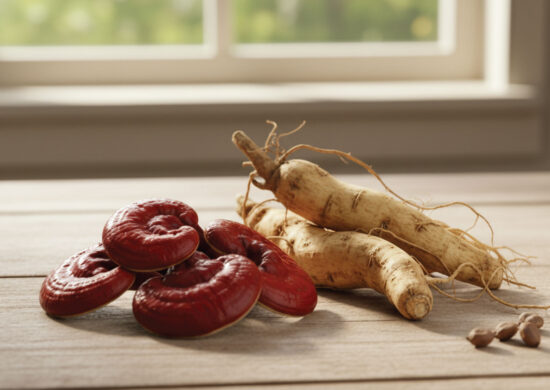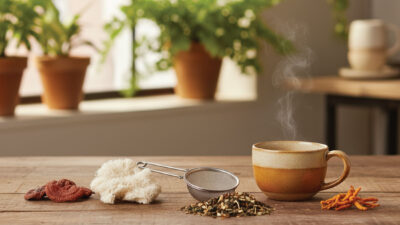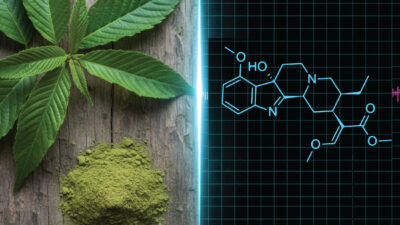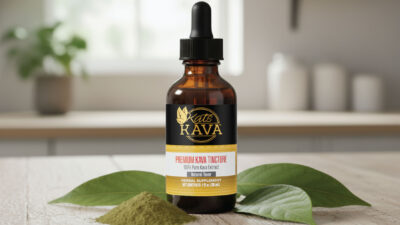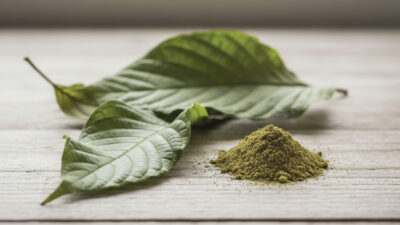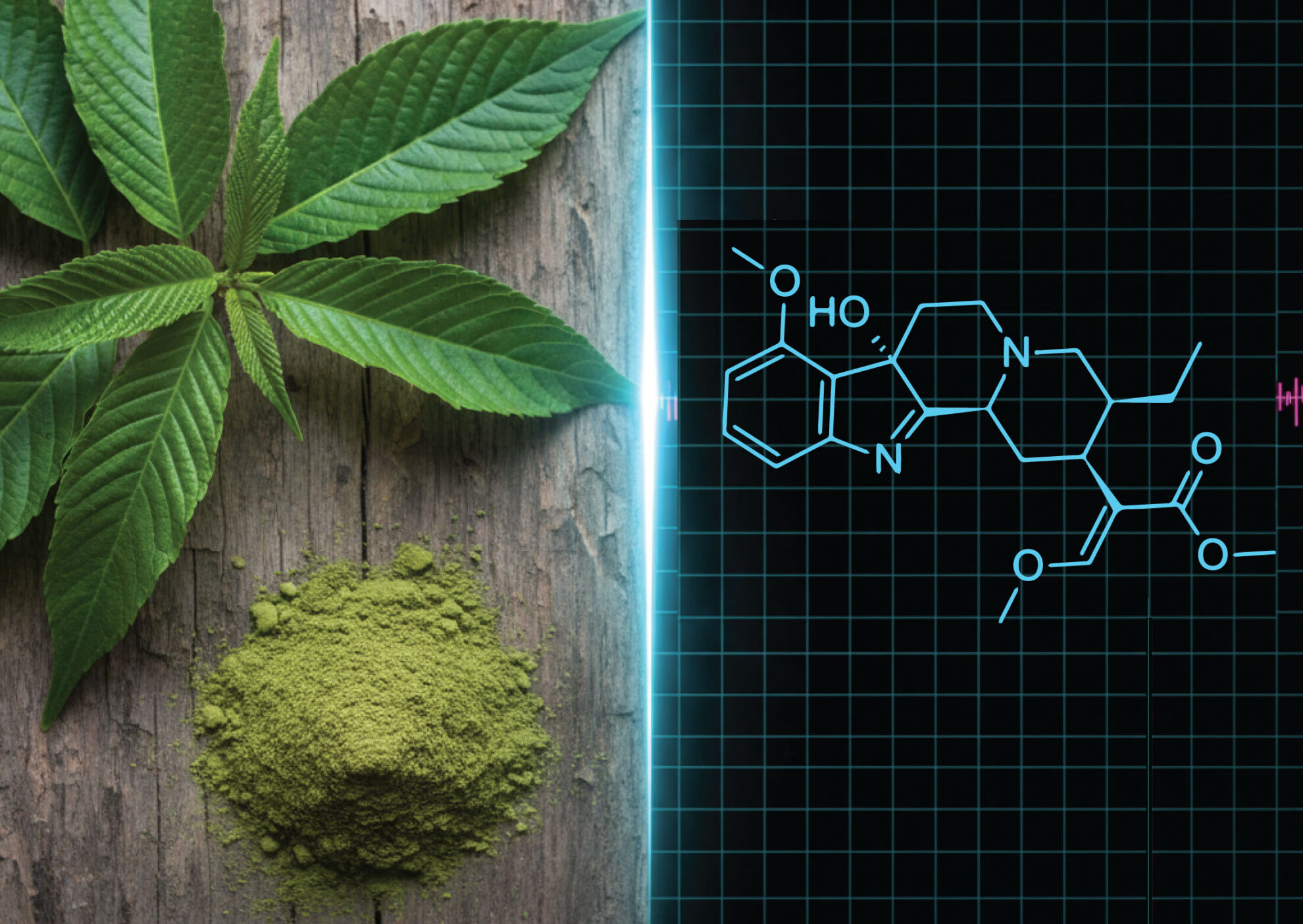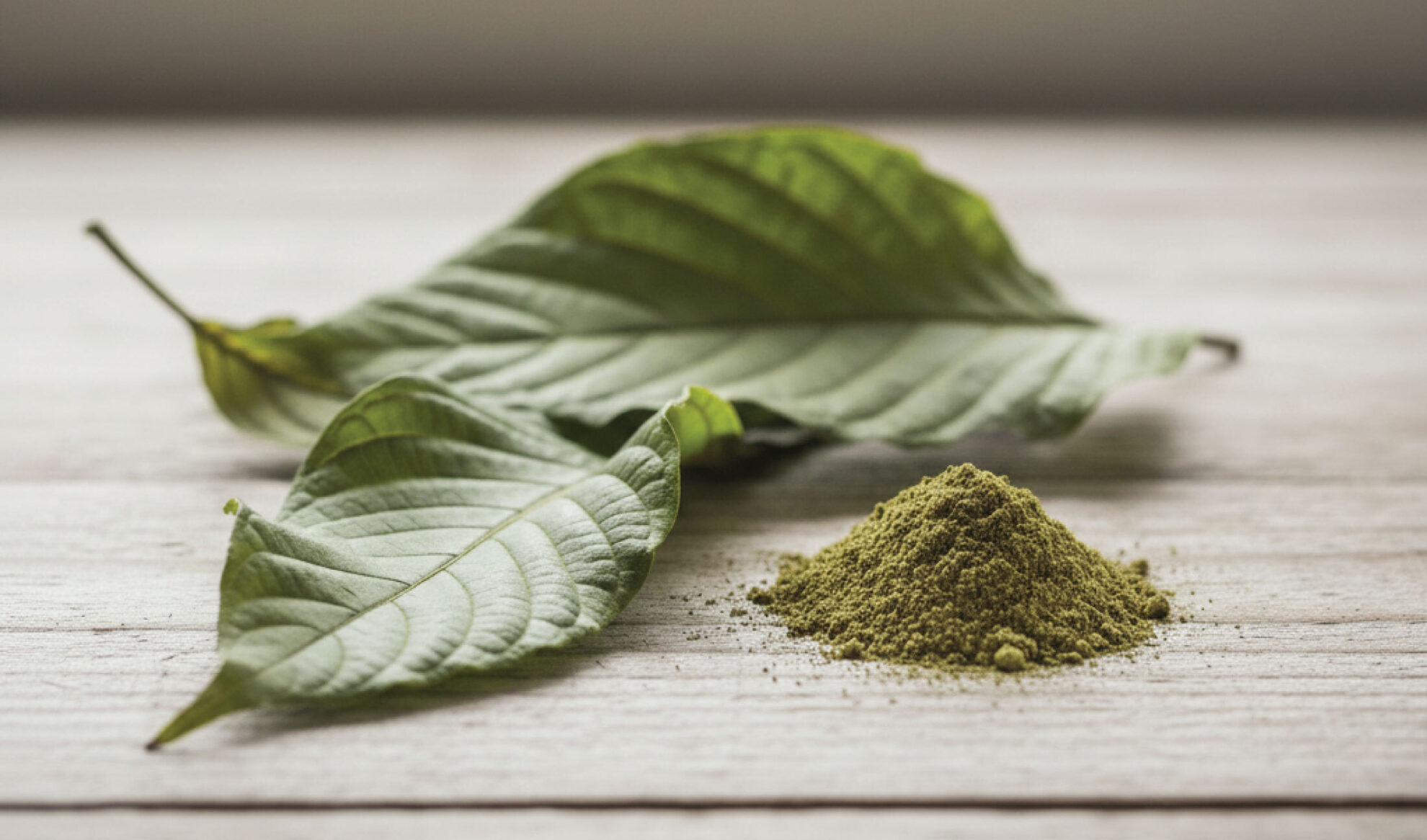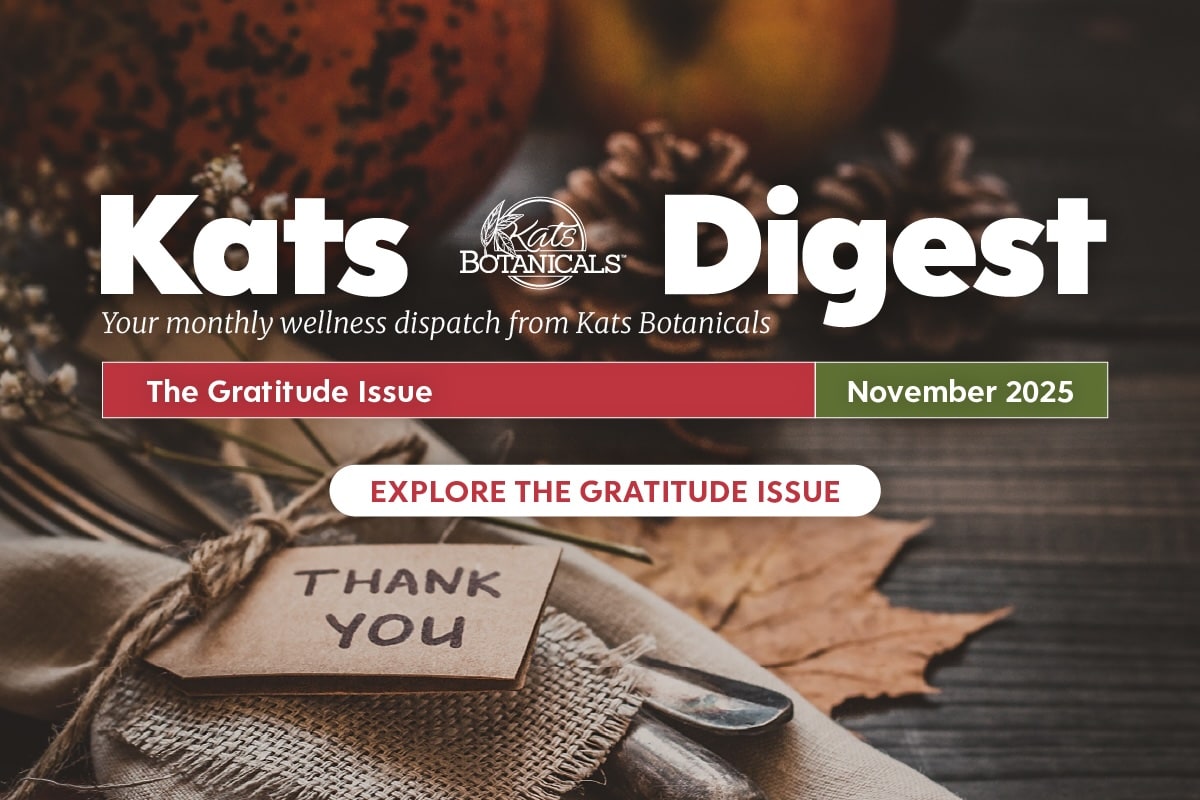Ashwagandha and reishi have both earned a space in the botanical wellness field. The science supporting their unique benefits is nothing short of impressive. Each works via their respective mechanisms in the body for potential health advantages. But what happens when you combine ashwagandha and reishi supplementation in one stacked routine?
We posit that using them in combination may offer a holistic well-being advantage. And if you’ll stick with us for the next few minutes, we’ll explain just why.
In this article:
- How ashwagandha and reishi work.
- Effects on cortisol, stress response, resilience, recovery, wellness, etc.
- Taking reishi with ashwagandha to support different aspects of health and wellness.
- How much of each you should take and when.
- Lastly, but very importantly, how to buy the best ashwagandha and reishi supplement.
Let’s explore the science behind ashwagandha and reishi benefits. And how to use them synergistically for the best results.
Why Combine Ashwagandha + Reishi?
First off, what are ashwagandha and reishi?
Ashwagandha (Withania somnifera)
A root herb widely used in Ayurvedic medicine for stress adaptation and vitality. Ashwagandha contains several active compounds, primarily withanolides. These naturally occurring compounds can influence the hypothalamic-pituitary-adrenal axis. A fancy way of saying they help regulate cortisol levels, which means a more balanced stress response. This calmer response to stress may help improve focus without overstimulation.
Reishi (Ganoderma lucidum)
A medicinal mushroom long valued in Traditional Chinese Medicine. Often called the “Mushroom of Immortality,” reishi has earned its reputation as a powerful symbol of balance and endurance. Reishi’s triterpenes and beta-glucans contribute to stress support, immune-balancing and antioxidative actions. These may help the body adapt to external and internal stressors.
Reishi and Ashwagandha Origins & Historical Uses
| Field | Ashwagandha | Reishi |
| Origin | India, North Africa, Middle East | China, Japan, Korea |
| Common Uses | Stress support, vitality, calm focus, mental clarity | Immune support, longevity, stress adaptation, emotional calm |
Why Take Ashwagandha and Reishi Together?
These two adaptogens form a cross-cultural wellness pairing with evidence-based support. Since they each target stress response and body wellness from a different angle, they work in tandem toward the same goal – a better you!
Ashwagandha helps regulate cortisol and supports focus, promoting steady daytime energy. Reishi is there for calm and restorative sleep. Together, they may improve stress response, resilience, and recovery for mind and body.
With everything your body and mind faces in a modern world, this adaptogenic pairing may help you stay a step ahead in maintaining balance. Let’s take a look at how they may empower you with wellness.
Learn more about functional mushrooms like reishi, lion’s mane, and turkey tail.
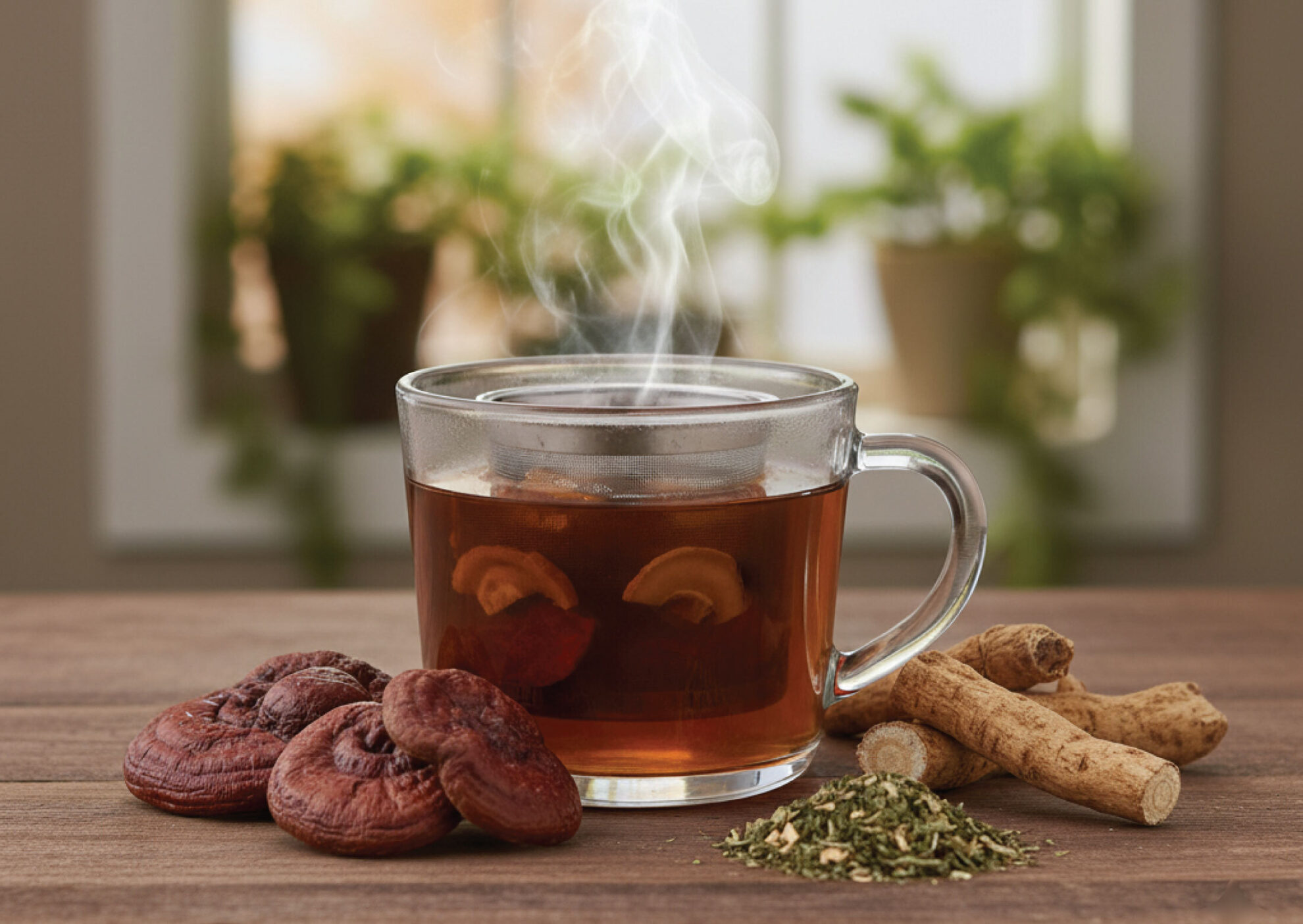 Bios & Mechanisms: How Each Works
Bios & Mechanisms: How Each Works
Ashwagandha
Scientific Name: Withania somnifera
Other names: Indian ginseng, Winter cherry, Ajagandha (used in some Ayurvedic texts)
Key Active Compounds: Withanolides (steroidal lactones), alkaloids, saponins, sitoindosides
How Ashwagandha Works | Scientific Support
Ashwagandha’s key active compounds, called withanolides, are steroidal lactones. Research indicates they can help modulate cortisol, the hormone released during periods of stress.
Research shows taking certain concentrations showed improved stress response and lowered cortisol levels. (Adults taking 300 to 600 milligrams of standardized extract daily.) Ashwagandha has also been studied for its potential to support endurance, focus, and as an adaptogen.
These effects make it a versatile botanical suitable for daytime use or as part of a broader wellness stack.
Reishi Mushroom
Scientific Name: Ganoderma lucidum
Other Names: Lingzhi, Mannentake, Red Reishi
Key Active Compounds: Beta-glucans, triterpenes (ganoderic acids), polysaccharides, peptidoglycans
How Reishi Works | Scientific Support
Reishi’s benefits stem from a combination of active compounds, each responsible for key contribution:
- Beta-glucans – Immune cell communication, activate macrophages and natural killer (NK) cells, immune response
- Polysaccharides – Antioxidant and overall immune support. Likely responsible for the longevity attributed to reishi in traditional Chinese medicine
- Triterpenes – Calming effects (modulating GABA receptor activity), support restful sleep
User reviews on reishi use are overwhelmingly positive, with some users warning that harvesting reishi from the wild can be risky. Mushroom species (poisonous vs medicinal) can look identical. It’s best to leave harvest to the professionals.
Combined Ashwagandha and Reishi Benefits: Let’s look at the Science
Taking ashwagandha and reishi together may provide well-rounded support for:
- Stress modulation.
- Improved sleep.
- Supported immune balance.
- Mental focus & calm.
- And even more emerging support pathways.
While research supports traditional use of each, research on their combined use is limited. One very promising study explored the combined use of ashwagandha and reishi. This is part of emerging scientific study showing their combined promise for wellness.
Think of their partnership as a balance between mind and body. Ashwagandha may calm stress and support focus. Reishi may improve sleep and help the immune system. Together, they offer a simple, holistic approach to wellness.
There’s no documented adverse interaction between the two herbs. That said, you should speak to your doctor before taking any herbal supplements.
How to Use: Dosage, Timing, and Form
Kats Botanicals discovered that while there are combination products out there, many fail to meet quality and efficacy marks across the board. (So, we made a tincture that did.)
Kats BotanicalsReishi and Ashwagandha Calming Tincture
Dosing: One tincture dropper, twice a day, easy!
- Lab-tested for safety and purity
- High-quality, carefully sourced ingredients
- Easy-to-use tincture format for quick absorption
- Professionally formulated for optimal dosing
- Transparent labeling and trusted manufacturing
Standardize Potencies for Therapeutic Dosing
Most research on ashwagandha uses certain metrics, and serves as a starting point for adult dosing:
- 300 – 600 mg of standardized root extract (5% withanolides, 30% polysaccharides)
- 500 to 1,500 mg extract taken daily
Multi-stage extraction is also helpful for providing products with full-spectrum profiles. This is important because some of the active compounds are easily extracted with water, but some require alcohols to remove them. A full-spectrum tincture delivers all the natural compounds together, so your body can get the most benefit.
Sourcing
Sourcing also matters so that your body can readily absorb the active ingredients, which provide the benefits. Unfortunately, many products are packed with fillers or made with subpar ingredients. The Certificate of Analysis and labeling are critical for determining their therapeutic value. Price isn’t always the best indicator of product efficacy.
Regular Dosing & Timing of Doses
Timing makes a difference. Separately, one might take Ashwagandha in the morning and reishi at night. But in combination, taking them regularly (usually twice a day) works well for most people. Arranging the doses this way can provide that round-the-clock support missing in other regimens.
As with many botanicals, patience and mindful observation are key to finding your optimal balance.
Liquid Extract Form (Superior to Capsules, Powders)
We briefly mentioned liquid, full-spectrum formats being the most bioavailable. Form influences efficacy.
You may find powder or capsule combinations, which provide dosing regularity and potency evenness. But these often take longer to absorb and are loaded with product fillers. Homemade teas offer more experience and flavor control but lack dose consistency. The best approach is to work with tinctures. Though you may have to measure with a dropper, you can still make teas or add them to a beverage for easy consumption.
Consistency matters most; it typically takes two to four weeks of daily use before full effects are felt.
Here’s how to make functional mushroom teas with our proprietary mushroom tincture blends.
Safety, Contraindications & Interactions
Both adaptogens are generally safe for most adults when taken at recommended amounts. Start with a low dose, monitor your response, and stay hydrated. Avoid combining multiple high-strength adaptogens without professional guidance. Always consult a healthcare provider before starting adaptogens. Especially if you have chronic conditions, take prescription medications, are pregnant, or breastfeeding.
Not all users or reishi or ashwagandha experience side effects. But being aware of the potential adverse effects arms you to have clear conversations with your doctor about their use.
Ashwagandha:
- May affect thyroid function, blood pressure, and blood sugar
- Mild digestive upset
- Drowsiness
- Headache
- Allergic reactions
- Avoid if pregnant, breastfeeding, or taking related medications
Reishi:
- May affect blood clotting and immune function
- Dry mouth
- Digestive upset
- Rash
- Dizziness
- Nosebleeds (rare)
- Increased bleeding risk if taking blood thinners or immunosuppressants
 How to Choose High-Quality Supplements
How to Choose High-Quality Supplements
Not all ashwagandha and reishi supplements are created equal. Knowing what to look for protects your health and ensures you get real benefits.
Standardization matters. Look for ashwagandha specifying at least 5% withanolides and reishi listing 30% or more polysaccharides. Dual-extracted reishi captures both water-soluble and alcohol-soluble compounds for maximum potency. Full-spectrum is best!
Source matters. Reishi should come from the fruiting body, and ashwagandha from the root only. These parts contain the full spectrum of active compounds, unlike blends or mycelium grown on grain.
Transparency matters. Look for a supplement brand that shows third-party testing. Also look for Certificates of Analysis, clear labels, and batch numbers. These indicate a brand that puts safety and consistency first.
| Feature / Quality Indicator | Kats Botanicals | Common Brands / Industry Standards | Notes for Consumers |
| Third-party testing | ✔ Verified | Often missing or incomplete | Look for lab reports or Certificates of Analysis confirming purity and safety |
| Certificates of Analysis (COA) | ✔ Provided | Rarely available | Check COAs for heavy metals, microbes, and active compound levels |
| Clear labeling | ✔ Accurate | Sometimes vague or missing serving info | Look for complete ingredient list, serving size, and instructions |
| Visible batch numbers | ✔ Present | Often absent | Batch numbers help track quality and trace recalls |
| Standardized actives | ✔ ≥5% withanolides (ashwagandha), ≥30% polysaccharides (reishi) | Varies; often unverified | Confirm percentages of key compounds on label or COA |
| Ingredient source | ✔ Root-only (ashwagandha), fruiting body (reishi) | May use leaves, stems, or mycelium | Only the root or fruiting body contains full bioactive spectrum |
| Extraction method | ✔ Dual extraction (water + alcohol) | Sometimes only one method | Dual extraction ensures both water-soluble and alcohol-soluble compounds are captured |
Premium wellness companies follow these standards to ensure purity and customer confidence. They also provide consistent products that deliver the full benefits of the botanicals.
FAQs About Ashwagandha and Reishi
Yes, most adults can take moderate doses of ashwagandha and reishi daily for several months. For longer-term use, many herbalists recommend cycling off for one week every two months to maintain sensitivity and effectiveness.
They can, though it’s best to begin with a simple combination before expanding. Ashwagandha and reishi pair well with gentler botanicals such as holy basil or cordyceps, but using too many strong adaptogens at once may overwhelm your system.
Some people report improvements in calm or sleep within a week, while deeper adaptogenic benefits often build over four to six weeks of consistent use.
Mild digestive changes, drowsiness, or dryness may occur, especially at higher doses. These effects are typically temporary and fade when the dosage is reduced.
While these botanicals are natural, potency can vary by product. Older adults or younger users should consult a healthcare professional to determine the appropriate dosage and ensure no medication conflicts exist.
Conclusion & Key Takeaways
The combination of ashwagandha and reishi offers a natural, time-tested path toward greater resilience, calm, and well-being. Together, they may help the body adapt to stress, support balanced energy, and encourage restorative rest. Their complementary actions reflect a harmony between traditional wisdom and modern science.
To use them safely, focus on consistency, mindful observation, and product quality. Purchase from reputable sources that test for purity and potency. Remember that adaptogens are most effective when paired with good sleep, hydration, and balanced nutrition.
By integrating these botanicals thoughtfully, you can cultivate a stronger sense of calm, vitality, and focus that carries through every part of your day. For more information on how to use adaptogenic mushrooms in your wellness routine, see our full line of Functional Mushroom Tinctures.

